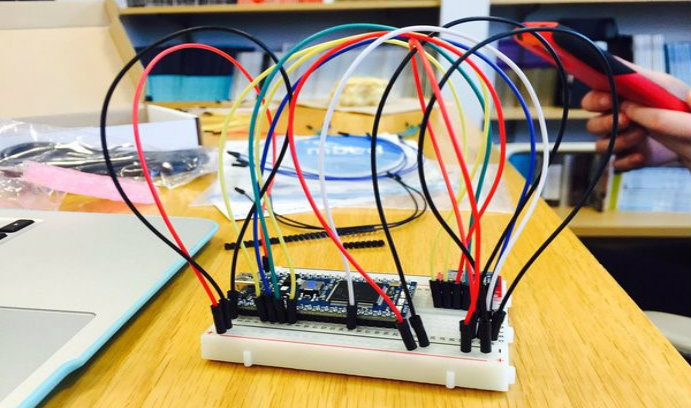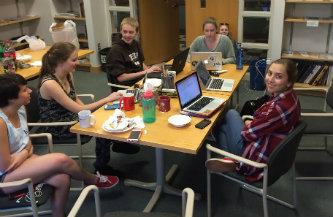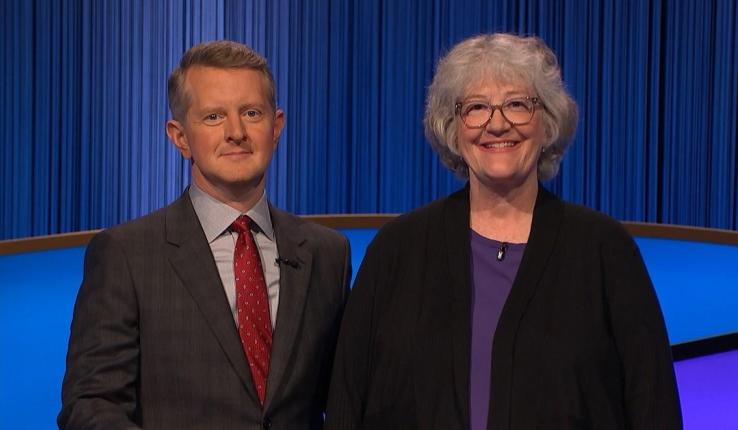Testing the boundaries of journalism

Students built sensors to 'heat map' Linderman Library in an attempt to determine the best places to study there, depending on the temperature.
Rather than rely on existing databases, news reporters are now collecting data from sensors and using that data to tell a story. This practice, called sensor journalism, is an emerging trend in the field as journalists at The New York Times, The Washington Post and other leading news outlets embrace data-driven story forms.
Jeremy Littau, assistant professor of journalism at Lehigh, had already taken note of the rise of data journalism when he began brainstorming ways to teach sensor journalism.
And so, the idea for a student-driven independent course study titled “Maker Journalism” was conceived.
To interest students, Littau said he needed to choose an intriguing course title. “Journalism, Data Analysis and the Scientific Method,” while accurate, wouldn’t convey the message he wanted to send to potential students—that data-driven journalism was not only accessible at Lehigh, but fun.
There would be no syllabus, curriculum, final exam or even a formal classroom. And, unlike traditional journalism courses, this one would utilize Arduino computers, scientific methods and empirical data gathering.
Gaby Morera ’17, recalls getting an email from Littau pitching the independent study course—which would explore “maker communities,”DIY (do-it-yourself) sensor kits and data-driven storytelling—in October 2015, well before students were due to register for the next semester.
“Even though we didn't have a lot of knowledge on the subject coming in,” Morera said about the group of students who received Littau’s pitch for J391 (the formal title for the class), “I remember all of us talking about what a good, hands-on experience it would be.”
With that in mind, in spring 2016 six students—Morera, Emily Okrepkie ’18, Anna Simoneau ’18, Samantha Tomaszewski ’17, Danielle Bettermann ’18, and Austin Vitelli ’17—guided by Littau, embarked on a semester-long, student-led independent study.
A ‘heat map’ of Linderman Library
The students, also Brown and White staff members, were already well versed in basic writing and reporting. The project required out-of-the-box thinking and an interdisciplinary approach.
Because the course was open-ended with no particular project in mind, the early days of the semester involved brainstorming what story they wanted to tell. All they knew was that they wanted to build a sensor to collect data, and then use that data to tell a story.
With research about room temperature and cognitive processes such as memory quality in mind, the team decided to “heat map” study spaces in Lehigh’s Linderman Library in an attempt to determine the best places to study in terms of temperature.
Rather than traditional college journalism courses, the students spent a majority of their time getting out of the “classroom” and getting hands-on, DIY experience learning new skills. The project involved soldering DIY sensors together, building Arduino kits, gridding the schematic of Linderman Library and placing the sensors on each floor.
After their initial attempt to heat map Linderman Library, the group needed to dramatically alter their plans and scale down the size of the project. Instead of mapping the entire library, they decided to focus on the Rotunda and Lucy’s Café to measure completely and only take measurements of specific spots of the Great Hall.
The team split into three groups and, using gridded floor plans, gathered data for different areas of the Rotunda and the café. Each team of two, using tape measurers set at 6 feet, collected data for their respective floor.
In the end, the project didn’t go exactly as planned. The students did find a few general trends they observed about the data set: The library is fairly warm and also very consistent, with the lowest temperature measured at 76.8 degrees Fahrenheit and the highest at 81.6 degrees Fahrenheit, meaning all the data points recorded fell within a 7-degree range. Initially led to believe the warmest floor in the Rotunda would be the top floor, they found it was actually the ground floor. One of the core findings showed that all of the temperatures measured were outside the optimal range for cognition and memory. Because the temperatures were taken in just one day, they acknowledged more research and interviews are needed to fully understand the data collected.
Rather than unveil concrete evidence that the temperatures in Linderman Library are or are not ideal for studying, the real goal of the project was to investigate the use of self-built sensors in the service of journalism using empirical data gathering.
When it comes to using technology to learn new skills, Littau says he’s more interested in the process than the product.
It’s important, Littau said, for students to spot the limits they’ve placed around their thinking about journalism, and push past them. “Giving the students a project based on a germ of an idea and helping them grow is part of that process. In this case it forced them to ask new kinds of questions and seek new answers,” Littau said.
Collaborative learning at Lehigh
The students agreed about one thing: Today’s journalists are no longer expected to pick one area of expertise within their field. Journalism requires knowledge of other fields and digital products; sensors, drones, bots, data and virtual reality are becoming a part of the storytelling process.
Okrepkie noted the importance of collaborating with people in other fields of study. “Journalism is becoming an increasingly interdisciplinary field,” she said. “There are few areas of study in existence that require no collaboration with other disciplines.”
The course, which was made possible by a grant from Lehigh’s Center for Innovation in Teaching and Learning, pushed the traditional boundaries of education, for both students and professors, while promoting technology in learning.
While not formally tied to Lehigh’s Data X initiative, the project is a natural fit with what Data X is trying to do at Lehigh in terms of data science across disciplines, Littau said. “I want our journalism students to be thinking more about the potential of data, and this was a case of giving them a non-threatening introduction to data journalism.”
The class, he said, was conceived as an attempt for students to seed the process of learning about data-driven journalism and to get them to ask questions and think about stories in ways they hadn’t before.
As a final project, the students compiled a seven-part multimedia project, Maker Journalism, chronicling the learning process.
Reflecting on the course, Littau said: “I had to give them room to answer their own questions without jumping in. That meant going against my own instincts at times. But it was all worth it. This might be the most rewarding class experience I’ve had at Lehigh.”
Posted on:





